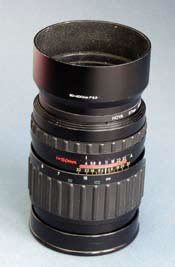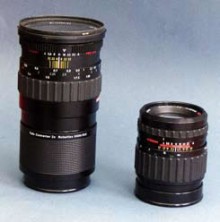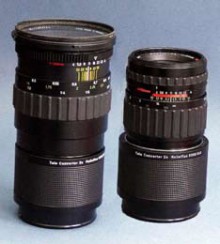First of all, when I say Rolleinars, I mean the lenses made by Mamiya-Sekor and Tokina for Rollei’s 35mm SLR system and NOT the close-up devices for the TLR range bearing the same name. These lenses offer a budget alternative to the Zeiss/Schneider alternatives. Whilst the quality may not be quite as good as Zeiss/Schneider lenses, it is very close indeed. In practice, excellent images can be obtained from these budget optics.
Rolleinars
Some years ago I acquired a 35mm SL35 outfit with 25mm, 50mm, 85mm and 200mm Zeiss lenses. Not long after, I decided to economise and sell these Zeiss lenses (which were quite old); and of course pocket the profit. Before doing so, I contacted my friend Dietmar Kanzer for his opinion. He said that I would not be disappointed. The 25mm sold via Ffordes for an excellent price but the 200mm had fungus in it and the 85mm had black specks on the rear element which wouldn’t clean off, so perhaps my move was a good one anyway.
I had already tested the 25mm Zeiss so when the 28mm Voigtlander Skopar arrived I tested it. Now I must point out that Rollei not only made the SL35E but also a Voigtlander version, hence the need for lenses bearing the same name. The test. The 25mm Zeiss lens barely managed 80LPM whilst the Voigtlander managed a more comfortable 68LPM and likewise the 200mm f3.5 Rolleinar. In practice there was no difference at all.
I wanted a 100mm lens as I have always worked on the principle of doubling (or halving) the focal length of the lens to obtain the next useful focal length. I had originally had 25mm, 50mm, 85mm and 200mm. Some say that a 100mm Rolleinar was never made, but, more recently I did see one advertised in the Amateur Photographer, although that could have been a misprint. (Rollei listed a Rolleinar-MC f2.8/105mm by Mamiya-Sekor and HFT Rolleinar macro f2.8/105mm by Kiron. Ed) I did buy a Pentacon 100mm f2.8, which (I am told) is a ‘five element’ lens made in the former East Germany. When I tested this I was a amazed to find that it was only a ‘hairs breadth’ behind the Zeiss Planar!
Rolleigons
These were also made by Tokina and were for the SLX, 6002 and 6006. You can use them on the 6008 but you lose some of the facilities. I have to admit that the name does not inspire confidence. The more modern name of ‘Rollei Apogon’ sounds much better. Years ago I had a 150mm Rollei Sonnar and I tended to look down on things marked ‘Rolleigon’. I firmly believed that the line-up of lenses in descending order was:
- Zeiss/Schneider
- Rollei made Zeiss
- Rolleigons
It just shows you how wrong you can be. In fact I tended to think of Schneider as being behind Zeiss as they tended to be on the cheaper Rollei cameras such as the Rolleicord. It is only recently that I realised that the Schneider Xenar was in fact a four element lens and is identical in construction to the Zeiss Tessar. From that, equal quality can be obtained from a Rolleicord Vb and a Rolleiflex ‘T’. With the Rolleicord you have a camera that is slower to use. I am led to believe that the Rolleiflex ‘T’ was offered with a Schneider Xenar but I have never seen one, which perhaps lends support for my ‘mistake’.
Rolleiflex 6008AF
More recently I have bought a Rolleiflex 6008AF (see main image). Again using my principle of doubling the focal length I bought 40mm and a 90mm. Now I know that I should have bought an 80mm Planar to adhere to my principle but I wanted the close focussing of the 90mm, not to mention the lack of needing a lens hood. It will focus down to a ratio of 1:2 without any accessories hence the deviation from my principle. For a longer lens I had a decision to make. Do I buy a x2 converter to give me a 80mm f8 lens OR do I buy a 150mm Sonnar f4? The Sonnar was more appealing but the price started at £350.00 whereas I actually bought a PQ converted x2 converter for only £199.00. This was both lighter and smaller than the 150mm. The downside is the loss of two stops making the 90mm f4 into a 80mm f8 lens.
More recently I thought about a 150mm again. Not only was the converted 90mm slow at f8 it was also large and quite heavy. The converter is smaller and lighter than a 150mm but the converter + a 90mm was larger and heavier than a 150mm! I decided to look in the Amateur Photographer to see how prices were. Ffordes had a 150mm Rolleigon at £ 99.00 and 150mm Sonnars at £229-£299. I contacted my friend Dietmar Kanzer for advice. I was surprised at his answer. He told me that in 987 the Sonnar design was quite old, but the Rolleigon, which was newly introduced, was at the ‘cutting edge’ of Tokina’s technology. Once again, he said that I would not be disappointed. The weights of the said items are as follows:
- X 2 Converter 410g
- 150mm Rolleigon 763g
- 150mm Sonnar 890g
- 90mm Makro Apo-Symmar 860g
Had I been left to my own devices I would have bought the Sonnar because they are the best aren’t they? I also noted in Ian Parker’s book ‘Complete Rollei 6000 Series’ that he put the Rolleigon ahead of the Sonnar in terms of contrast. Dietmar also told me that service facilities still exist for these Rolleigon lenses although they cannot be converted to PQ.
So, decision made! They work perfectly well on a 6008 camera but you lose some facilities. These are as follows:
- Shutter priority
- Programme
- Multi-spot metering
In fact the camera will not let you take a picture if set to any of these modes. Also the aperture chosen is not displayed in the finder but the shutter speed chosen by the camera is, whilst you keep the grey button pressed. The display disappears as soon as you let go. Using the exposure lock leaves the shutter speed chosen on display. No big deal for me but it might bother some people. Mr. Cad had a 150mm PQS at around £1400, a lot to pay for those extra facilities.
Lens testing
How does it perform? In a word, excellently. I used a lens testing chart but it is only for 35mm lenses. I stood the camera at a distance so that the chart only covered the 35mm format. The results are as follows:
150mm f4 Rolleigon
| Centre | Edge | |
|---|---|---|
| F4 | 80- | 68- |
| F5.6 | 80 | 80 |
| F8 | 80 | 80 |
| F11 | 80 | 80- |
| F16 | 80 | 80- |
| F22 | 80- | 80- |
| F32 | 68- | 68- |
This next test for comparison is my 80mm Rollei Planar for the Rollei 35RF. This is a 6 x 6 lens head from the current TLR mounted in a 35mm R/F coupled focussing mount by Cosina.
80mm Rollei Planar f2.8
| Centre | Edge | |
|---|---|---|
| F2.8 | 68 | 68 |
| F4 | 80 | 80 |
| F5.6 | 80 | 80 |
| F8 | 80 | 80 |
| F11 | 80 | 80 |
| F16 | 80 | 80 |
| F22 | 80 | 80 |
This next lens is a Leitz 35mm f3.4 Apo-Telyt and again is for comparison
Leitz 135mm f3.4 Apo-Telyt
| Centre | Edge | |
|---|---|---|
| F4 | 80 | 80 |
| F5.6 | 80 | 80 |
| F8 | 80 | 80 |
| F11 | 80 | 80 |
| F16 | 80 | 80 |
| F22 | 68 | 68 |
Now there is more to testing a lens than LPM but at least it gives you an idea of what to expect. This is a lens/film/Ken Williams test! Setting it up really is quite a long-winded process. The three lenses are very close with the Rolleigon being the poorest. The difference is so slight that I would defy anyone to use any of these lenses in the 35mm format at f5.6 or f8 AND tell them apart. The Leitz lens had a very slight ‘edge’ at full aperture over the Rollei Planar but then the Planar had a very slight ‘edge’ over the Leitz lens at f8. Swings and roundabouts I think.
Now I know that I have equated the Rolleigon in 35mm terms. This is partly due to the fact that the test chart is for 35mm format only and partly due to the fact that I have 60 rolls of slide film which I can cut down to 35mm when processed. This makes my 6008 even more versatile and saves carrying another camera and lenses.
Now anyone wanting another lens and is considering a Rolleigon then do not hesitate. They are excellent but then they are from Rollei aren’t they? Now it may appear that I am not being fair to x 2 converters. I find them to be very good and I will deal with them in a future article.




